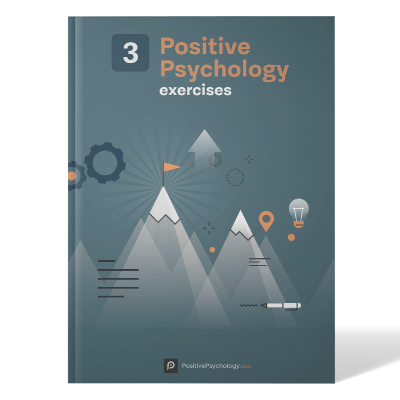Positive Psychology Examples: 5 Ways to Put it Into Practice
 Positive psychology is the scientific study of positive experiences, states, and traits.
Positive psychology is the scientific study of positive experiences, states, and traits.
It grew as a field after the realization that psychology focused largely on dysfunctional and pathological disorders while largely ignoring the research of what conditions might lead to optimal functioning.
“The aim of positive psychology is to catalyze a change in psychology from a preoccupation only with repairing the worst things in life to also building the best qualities in life.”
Martin Seligman
This scientific understanding is translated into multiple exercises and interventions aimed at increasing life satisfaction, wellbeing, positive emotions, or other desirable states in individuals, organizations, and societies. That’s what makes it an applied science.
“Once you start making the effort to ‘wake yourself up’ – that is, be more mindful in your activities – you suddenly start appreciating life a lot more.”
Robert Biswas-Diener
Here is a list of some positive psychology examples, or positive psychology interventions.
Before you continue, we thought you might like to download our three Positive Psychology Exercises for free. These science-based exercises will explore fundamental aspects of positive psychology including strengths, values, and self-compassion, and will give you the tools to enhance the wellbeing of your clients, students, or employees.
This Article Contains:
Five Examples of Positive Psychology Interventions
Tangible action items do not need to be huge changes in your lifestyle. There are several “little tips” that can change your habits, or minimally, start re-wiring your brain for better health and wellness.
Which of these tips do you prefer, and do you have other “interventions” that help? We would love to hear from you in our comments section.
1. Gratitude Journal
It’s probably one of the most well-known positive psychology interventions. The world’s leading expert on gratitude, Robert Emmons, defines gratitude as:
” A felt sense of wonder, thankfulness, and appreciation for life.”
Gratitude is a great buffer against negative emotions such as envy, hostility, worry, and irritation. It involves a focus on the present moment and appreciating what is instead of focusing on what could be. People who are frequently grateful are:
- Happier;
- More energetic;
- More hopeful;
- Experience more frequent positive emotions.
If you enjoy writing, keeping a gratitude journal is a great way to practice gratitude. Pick a time of the day when you can reflect and relax for a while and ponder on the three to five things for which you are grateful, no matter how small or big they are.
Try doing this every day for a week and notice how you feel. As with all the different activities, you might need to customize this exercise to best fit your characteristics and values.
To customize you can adjust:
- The frequency;
- The format (you might simply choose to contemplate instead of writing);
- Or the number of things to focus on (just one instead of three).
Some people will notice an ungrateful thought and replace it with a grateful one; for example, my husband forgot our anniversary, but he is working very hard so that we can go on our dream vacation. The point is to make this exercise work for you and fit into your lifestyle.
And remember that when we habituate to certain things their impact might diminish, so coming up with ways of keeping the strategy fresh will also affect its outcome.
Here’s a short video of Emmons on gratitude:
It makes sense, that gratitude is a value we have to practice if we want to find deeper calm and meaning.
2. The Gratitude Visit
Researchers have found that the practice of gratitude may be especially effective when expressed directly to another person.
If there’s someone who had a significant impact in your life, someone who went out of their way to help or support you, or someone you feel very blessed to have in your life, write a gratitude letter to that person. State in detail what he or she did and express your appreciation in concrete terms.
Then, if possible, arrange so that you can read the letter out loud to that person, either on a special day or just a random one. As part of my Executive Masters in Positive Psychology, we did all the positive psychology interventions and found that this was one of the most powerful.
Martin Seligman, one of the founders of Positive Psychology, and his colleagues tested the benefits of this intervention in a study.
In the experimental condition, they got participants to complete the gratitude visit over the course of a week. In the other conditions, participants were given different self-guided happiness exercises.
The participants in the gratitude visit condition experienced the largest effects in the entire study and reported feeling happier and less depressed, even one month after the study.
Another study by Sonja Lyubomirsky’s laboratory found that simply writing the gratitude letter and not sending or reading it to the other person still produced significant boosts in happiness.
We encourage you to try it out for yourself, adding your own personal twist to it. After, reflect on:
- The impact the exercise had;
- How you felt while you were doing it;
- How you felt after the exercise and how long it lasted;
- How you are going to continue your gratitude practice.
3. Best Possible Self
Laura King, professor at the University of Missouri, Columbia, designed a systematic optimism intervention.
She asked participants to come to her laboratory for four days in a row. Every day participants were asked to spend twenty minutes writing a narrative description of their “best possible future selves.” They were essentially asked to contemplate the best possible future for all the different areas of their lives.
This intervention involves imagining your most important and deeply held goals, and picturing life after you’ve accomplished them in as much detail as you can.
Laura King found that participants who wrote about their visions for twenty minutes, four days in a row:
- Had immediate increases in positive moods;
- Were happier several weeks later;
- Reported being sick less often than participants who were asked to write about other topics.
Consider your most significant goals in the different areas of your life: professional, social, romantic, physical, or any other category of your choice.
Then imagine your life after everything has gone as well as it possibly could:
- What would you be doing?
- Where you would be living?
- How would your days look like?
- How would you feel?
This exercise can help you to see explicitly your own understanding of what self-actualization might mean in your case.
4. Daily Strength Awareness
Character Strengths and Virtues is a groundbreaking classification of widely valued positive traits. The authors Martin Seligman and Chris Peterson studied all the major religions and philosophical traditions to find that the same six virtues were valued across all cultures.
These virtues (humanity, courage, wisdom, etc.) needed to be subjected to scientific study, so they focused their research on the character strengths that lead to those virtues. They followed that by creating tools for their measurement.
Positive psychology draws on many different tools to help individuals and organizations identify their strengths and use them to increase and maintain their levels of wellbeing.
The development of strengths requires a process of self-examination, self-discovery, and reflection. For someone to really understand what their strengths are, they need to look inward. This tool is a valuable way to enhance self-awareness.
Use the table below to list:
- Date;
- Brief description of the activity;
- What you experienced during the activity;
- How much you enjoyed the activity;
- The amount of energy the activity provided;
- The possible strength or strengths being used.
5. Mindfulness Meditation
Mindfulness meditation is a focus on the present moment achieved through the directing of attention towards one’s immediate experiences, thoughts, feelings, emotions, and sensations.
It involves paying attention to our thoughts and feelings with a sense of acceptance and non-judgment. In very simple terms it implies that instead of focusing on what we should be feeling or experiencing, we are present and aware of how we are really feeling. It is not about trying to change anything, just tuning in to our experience at the moment.
With its roots in Buddhist meditation, mindfulness meditation has made its way to a mainstream culture largely through the work of Jon Kabat-Zinn and his Mindfulness-Based Stress Reduction (MBSR) program.
A large body of research has established mindfulness meditation as one of the most powerful and effective tools to promote psychological wellbeing.
According to APA (American Psychological Association), the research on mindfulness has identified as benefits:
- Reduced rumination;
- Stress reduction;
- Increases in working memory;
- Increased ability to focus;
- Less emotional reactivity;
- More cognitive flexibility;
- Relationship satisfaction.
One of the most common forms of mindfulness meditation is the Body Scan. Below is a guided 5 Minute Body Scan to help you experience first hand the benefits of mindfulness meditation.
A Take-Home Message
Positive psychology has shown that our wellbeing and satisfaction can be increased through our efforts and intentional activities. It takes practice, it might not always be easy, but it will most certainly be worth the effort.
Have you tried any of these interventions before? Which one had the biggest impact on your life?
We’d love to hear from you, so please leave a comment below.
We hope you enjoyed reading this article. Don’t forget to download our three Positive Psychology Exercises for free.
- American Psychological Association, A.P.A. (2016). What are the benefits of mindfulness? Retrieved from https://www.therapistaid.com/worksheets/what-is-trauma.pdf.
- Lyubomirsky, S. (2007). The how of happiness: a scientific approach to getting the life you want. New York: Penguin Audiobooks.
Let us know your thoughts
Read other articles by their category
- Body & Brain (41)
- Coaching & Application (49)
- Compassion (27)
- Counseling (46)
- Emotional Intelligence (23)
- Gratitude (16)
- Grief & Bereavement (19)
- Happiness & SWB (35)
- Meaning & Values (26)
- Meditation (21)
- Mindfulness (42)
- Motivation & Goals (42)
- Optimism & Mindset (33)
- Positive CBT (24)
- Positive Communication (21)
- Positive Education (41)
- Positive Emotions (28)
- Positive Psychology (33)
- Positive Workplace (38)
- Relationships (31)
- Resilience & Coping (33)
- Self Awareness (21)
- Self Esteem (38)
- Software & Apps (23)
- Strengths & Virtues (28)
- Stress & Burnout Prevention (27)
- Theory & Books (42)
- Therapy Exercises (30)
- Types of Therapy (53)





What our readers think
Very good article it’s great:)
Caterina thank you, thank you, thank you. I am currently on day 5 of 28 days of gratitude. I feel uplifted and energised. I am also regularly meditating and working on raising awareness of self with mindfulness.